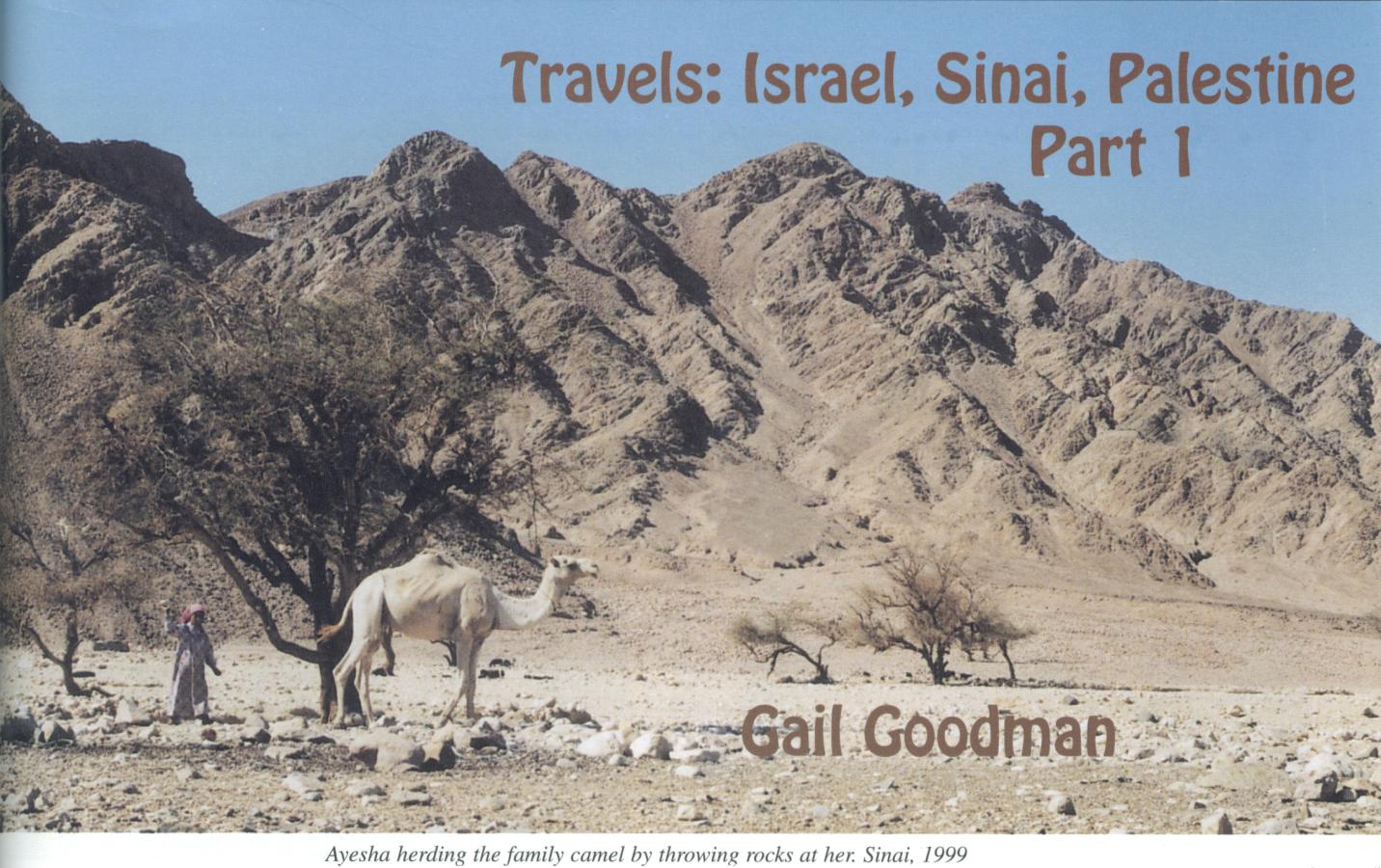 Travels are like dreams....they are lived through the mind, though the body is the vehicle. When the particular journey ends, the mind lives it over and over, and the real, and the thought, and the felt merge into a memory, and that fades and it seems the journey was a dream. So, I'll try to share the travels before the tactile sensations become too vague to recall. Seeing into the lives of the Bedouin was for me another long held desire. Many of us who are fascinated by Saluqis have also been fascinated by the peoples who have bred them and the adventures of those westerners who have traveled through the domains of the breed. Having read Lady Anne's Pilgrimage, accompanied by her husband, and "the desert 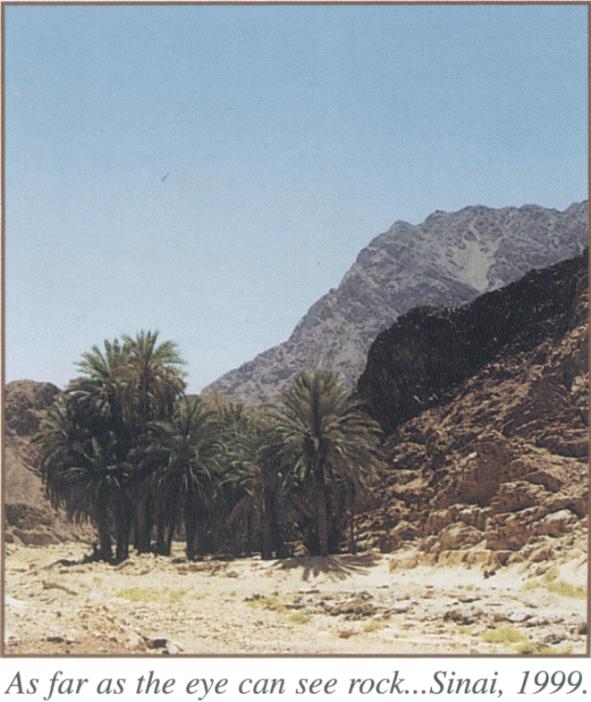 queen",
Gertrude Bell's story of marching with her retinue of servants, gowns,
china, linens, armed with her rifle and
pistols, the "romance" seeps into one's expectations. Then
there is Raswan, Davenport, Dumas, Brown with their
wonderful horse adventures. The only really grim stories I
remembered were from Charles Doughty's Travels in Arabia Deserta; all the others were full of exhilaration and
freedom! The Bedouin, all Bedouin, any Bedouin, had
assumed mythical personage in my mind. I had to see real
Bedouin in Sinai. queen",
Gertrude Bell's story of marching with her retinue of servants, gowns,
china, linens, armed with her rifle and
pistols, the "romance" seeps into one's expectations. Then
there is Raswan, Davenport, Dumas, Brown with their
wonderful horse adventures. The only really grim stories I
remembered were from Charles Doughty's Travels in Arabia Deserta; all the others were full of exhilaration and
freedom! The Bedouin, all Bedouin, any Bedouin, had
assumed mythical personage in my mind. I had to see real
Bedouin in Sinai. Though Clinton Bailey had made many treks with the Bedouin of Sinai over the thirty-two years that he has been collecting material on the cultures, poetry, proverbs, and legal systems of the various tribes, the trip I accompanied him on was only a few days to clarify and elaborate on material for the book he is readying for publication. The data collection method used was ethnographic research which demands long hours of discussion for the researcher to attempt to understand and accurately record the world view, the perspective and knowledge of the people being studied. Once every few months Dr. Bailey returns to the camps and houses of Bedouin "experts" in the areas he is studying, to review and refine his understanding and revise his material. 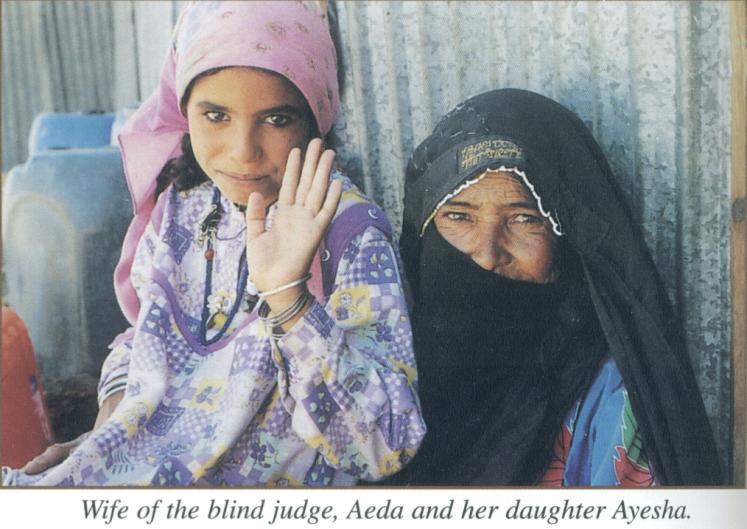 I was the silent observer of this process.
The only assertive gesture that I made was asking
I was the silent observer of this process.
The only assertive gesture that I made was asking permission to take photographs.....which I did in every setting. In all settings, other than the meeting with Anez (who I had actually photographed upon our arrival, as part of the general oasis setting, without knowing who he was), people nodded assent. By accompanying Dr. Bailey I was walking into the real world of real Bedouin for a few moments of their real lives. Since I, too, am an ethnographer, though my work has been predominantly in American and Native American classrooms, in the area of language use and cross-cultural communication, my attention, what little I could focus, was naturally drawn to the personal interactions of the people around me. 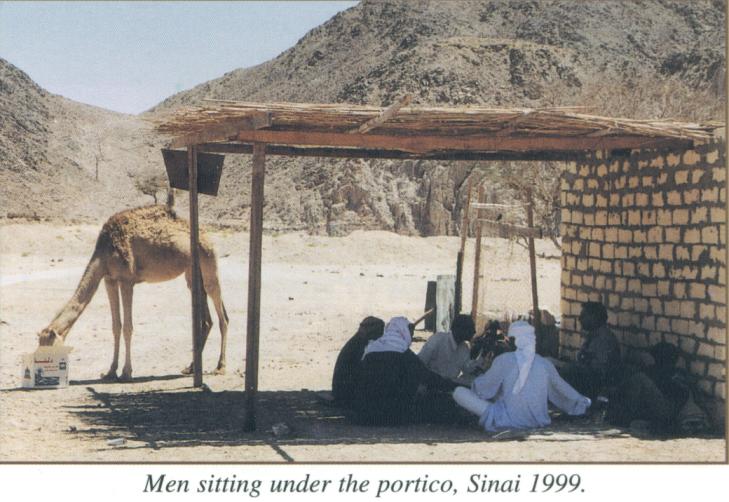 I quickly realized that wealth is its own calling card, among the Bedouin
of the deserts as among westerners. Women travelers like Lady Anne and
Gertrude Bell were treated "as men" for the most part. In all cultures
there is a "society of women" and this is certainly the case in Bedouin
culture. In Lady Anne's writing one glimpses into it because she often
mentions leaving the men and going to visit with the wives and children,
making it quite clear that they live separatelives, apart from the men.
Gertrude Bell, on the other hand, dresses in her evening gown and dines
with the Sheikhs. She must have
been quite incredible. I, however, had been instructed to be unobtrusive so as not to disrupt the intense effort of concentration involved in the data collection process. I was left totally to my own thoughts.
I quickly realized that wealth is its own calling card, among the Bedouin
of the deserts as among westerners. Women travelers like Lady Anne and
Gertrude Bell were treated "as men" for the most part. In all cultures
there is a "society of women" and this is certainly the case in Bedouin
culture. In Lady Anne's writing one glimpses into it because she often
mentions leaving the men and going to visit with the wives and children,
making it quite clear that they live separatelives, apart from the men.
Gertrude Bell, on the other hand, dresses in her evening gown and dines
with the Sheikhs. She must have
been quite incredible. I, however, had been instructed to be unobtrusive so as not to disrupt the intense effort of concentration involved in the data collection process. I was left totally to my own thoughts.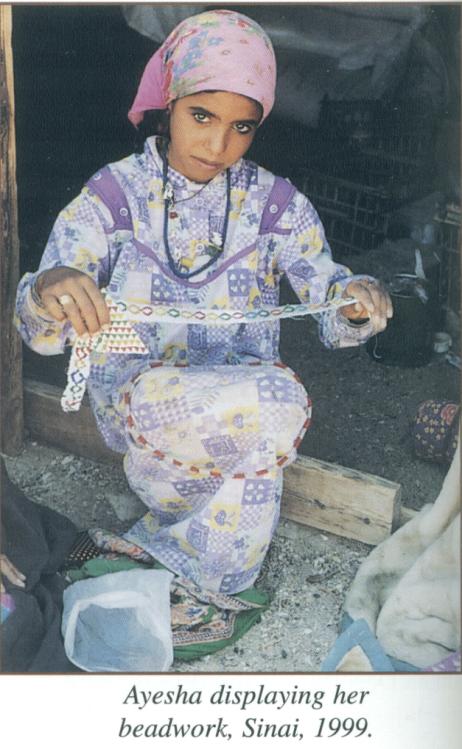
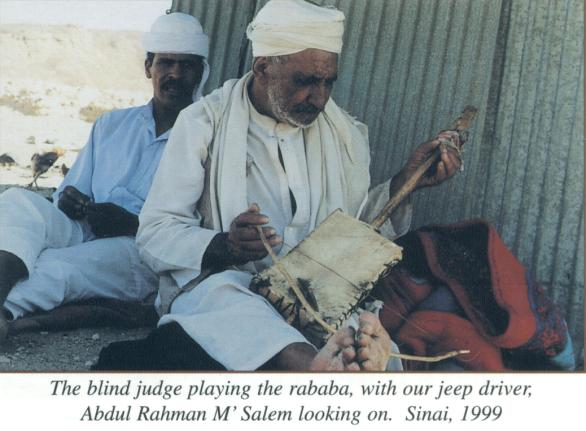 Sinai, as I said, was pure emotion. In such vast barrenness, awesome in a primeval way, the human body, human existence is so clearly tenuous, so clearly dependant on water, on meager
vegetation, on livestock, on the help of one's "people"...intellectualism
seems irrelevant and all thoughts,
mine at least, became focused on the elements of survival. Or, maybe
because I was just a visitor, for
moments, all I saw was the harshness of Sinai and I was overwhelmed. At
the same time, however, in every environment where the Bedouin sat with
Clinton Bailey, in camps where as far as the eye could see in every
direction there was rock, nothing but rock and maybe a leafless tree or
stand of palms in the distance, as soon as the tea was poured there was
laughter and delight and talk and good humor. I must say, the Bedouin
character, the little I saw, was as awesome as Sinai itself. That people
could be so full of mirth and so generous, when their lives are lived in
such harsh places, with so little material wealth, is the miracle of the
human spirit.
Sinai, as I said, was pure emotion. In such vast barrenness, awesome in a primeval way, the human body, human existence is so clearly tenuous, so clearly dependant on water, on meager
vegetation, on livestock, on the help of one's "people"...intellectualism
seems irrelevant and all thoughts,
mine at least, became focused on the elements of survival. Or, maybe
because I was just a visitor, for
moments, all I saw was the harshness of Sinai and I was overwhelmed. At
the same time, however, in every environment where the Bedouin sat with
Clinton Bailey, in camps where as far as the eye could see in every
direction there was rock, nothing but rock and maybe a leafless tree or
stand of palms in the distance, as soon as the tea was poured there was
laughter and delight and talk and good humor. I must say, the Bedouin
character, the little I saw, was as awesome as Sinai itself. That people
could be so full of mirth and so generous, when their lives are lived in
such harsh places, with so little material wealth, is the miracle of the
human spirit. 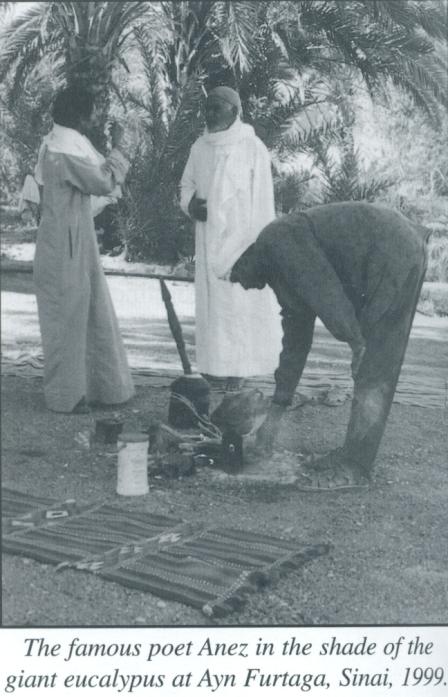 The lives of the Bedouin I met, during the moments that I met them, were
not "romantic", though for me, as a westerner, merely experiencing the
little of their lives that I did was an adventure. However, it was not
romantic. It was hot, extremely hot. Two camps were in settings as barren
as could ever be imagined, the only shade being porticos built out on one
side of the main building. As a woman, I was either at the edge of the
shade, or, in the camp of the blind judge, I was at the side of the house
with the man's wife and daughter where a shadow was just barely cast over
us by the building. The wife tended the fire, so there was additional
heat. The lives of the forty-year-old mother, Aeda, and her ten-year-old daughter, Ayesha, seemed harsh to the extreme. All socializing was among
the men. Nothing was said directly to any of us, the women, except that
tea was frequently summoned.
The lives of the Bedouin I met, during the moments that I met them, were
not "romantic", though for me, as a westerner, merely experiencing the
little of their lives that I did was an adventure. However, it was not
romantic. It was hot, extremely hot. Two camps were in settings as barren
as could ever be imagined, the only shade being porticos built out on one
side of the main building. As a woman, I was either at the edge of the
shade, or, in the camp of the blind judge, I was at the side of the house
with the man's wife and daughter where a shadow was just barely cast over
us by the building. The wife tended the fire, so there was additional
heat. The lives of the forty-year-old mother, Aeda, and her ten-year-old daughter, Ayesha, seemed harsh to the extreme. All socializing was among
the men. Nothing was said directly to any of us, the women, except that
tea was frequently summoned. Aeda smoked her cigarettes, one after another, through her veil. She tended the fire almost obsessively, controlling the flame perfectly. She poked the fodder with just the pressure needed to keep the flame alive, then picked up pieces of gravel and rollede almost obsessively, controlling the flame perfectly. She poked the fodder with just the pressure needed to keep the flame alive, then picked up pieces of gravel and rolled them through her leathered fingers. Maybe she was listening to the men talking, maybe she was thinking her own thoughts; I had no way to actually enter her world. I remember that I showed her pictures of my children and I know this is how I learned her name and her daughter's name and age. I think she would have liked to talk to me, and I to her, had we had words. But, maybe living in such vast silence, females relegated to silent, passive corners, we would not have talked even if we had a common language. Maybe the common language of Bedouin women is silence in the presence of men. Aeda was able to convey that she wanted me to ask Dr. Bailey for arak for her stomach pains. I was relieved to discover that he had anticipated her request. 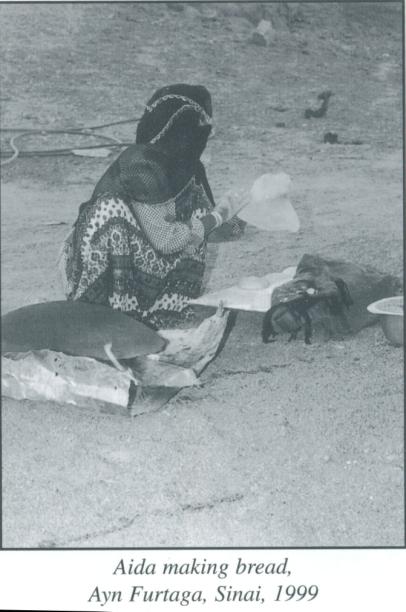 Before ten-year-old Ayesha went about her chores, she brought from inside of the building we were leaning against a bag, which contained tiny beads and samples of beadwork she was mastering. She placed three different examples of beadwork into my hands and I looked at each carefully and tried to convey how nice I thought the work was. I tried to give the pieces back to the child but she indicated that I was to keep them. As I looked at the long strip of tightly woven patterns, it occurred to me that this would be a perfect inset for Saluki collars, and one of my "missions" was to purchase authentic Bedouin craftwork for Sirius Enterprises. Ayesha's beadwork would be perfect and placing an order with her might give her something to anticipate and a small source of income. As we were readying to leave, Dr. Bailey explained what I wanted Ayesha to make and he also gave her some money as a token for the beadwork she had given me. This would help buy the beads and materials for the order for Sirius, which will be collected during Dr. Bailey's next visit to the camp. 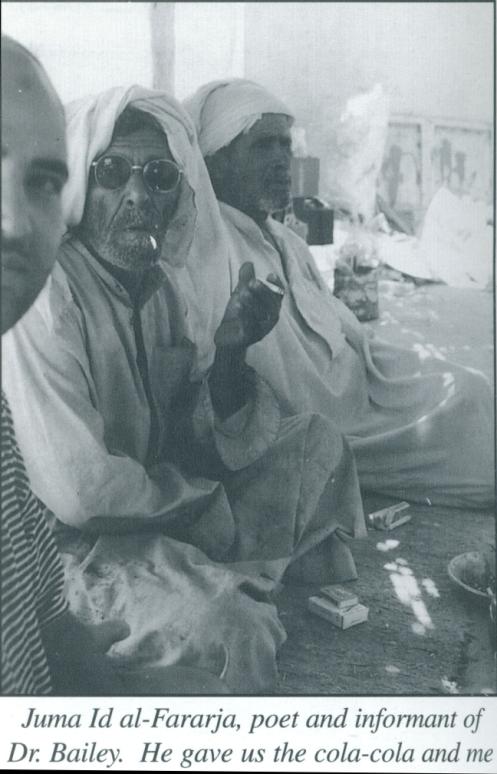 In contrast to the silence of the women, their invisibility in the Sinai Bedouin camp setting, this was not the case in the majlis of the man in Dahab. There all of the women, the mother in law, the young wife, and the daughter spoke frequently and with 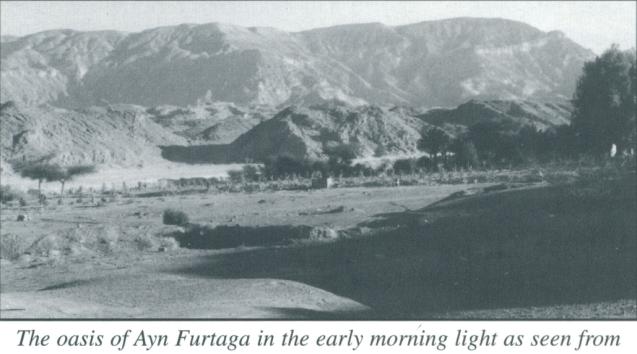 animation
during our visit. In the interior of Sinai, only the men conversed. When all of the "beards" gathered at the camp of Anez to welcome Dr. Bailey,
the wives of the sons of Anez, his
daughter, and I were all "isolated" in the women's quarters. The camp has
a satellite dish so Egyptian and
Kuwaiti soap operas are beamed in, as well as a few other stations, for
the few hours at night while the generator is running, but the women had
no place in that evenings festivities for the guest. animation
during our visit. In the interior of Sinai, only the men conversed. When all of the "beards" gathered at the camp of Anez to welcome Dr. Bailey,
the wives of the sons of Anez, his
daughter, and I were all "isolated" in the women's quarters. The camp has
a satellite dish so Egyptian and
Kuwaiti soap operas are beamed in, as well as a few other stations, for
the few hours at night while the generator is running, but the women had
no place in that evenings festivities for the guest. 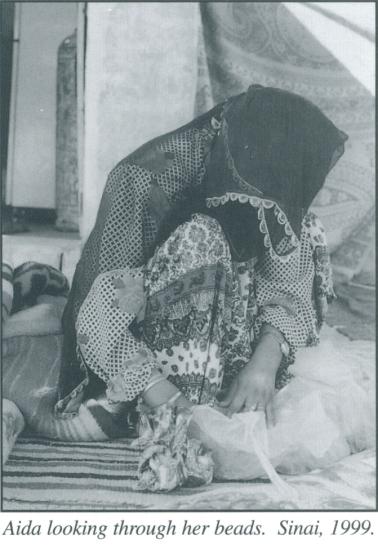 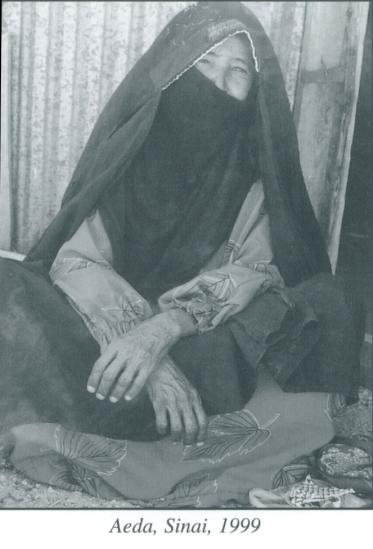 Food
prepared by the women was
carried down to the main camp by an Egyptian
hired man and he brought the dishes back up
to the women's quarters the next morning,
with, I assume, highlights from the festivities. He was served coffee as the women seemed
to be prying him for information while at the
same time chiding him for impudence in his
comments. The hired man was clearly a
conduit of information and seemed to sense
his indispensability. After he left, one of the
sons of Anez came for his breakfast, prepared
by his energetic wife, Aida. He was interested
in chatting a bit, which we did in both Hebrew
and English. I gave him the copy of Sighthound
Review that I'd carried
everywhere, and as he
leafed through it he commented that his father
loved Saluqis. I asked would I be able to talk to
his father and he said certainly, he'd arrange it,
how much time would I need. This question
made me extremely nervous. It felt like I was
being invited to an audience with a Bedouin
potentate, which actually was the case, and I
felt totally intimidated. As it turned out, the
meeting did not go well, but I learned a critical
lesson about collecting information in this
cultural context. Food
prepared by the women was
carried down to the main camp by an Egyptian
hired man and he brought the dishes back up
to the women's quarters the next morning,
with, I assume, highlights from the festivities. He was served coffee as the women seemed
to be prying him for information while at the
same time chiding him for impudence in his
comments. The hired man was clearly a
conduit of information and seemed to sense
his indispensability. After he left, one of the
sons of Anez came for his breakfast, prepared
by his energetic wife, Aida. He was interested
in chatting a bit, which we did in both Hebrew
and English. I gave him the copy of Sighthound
Review that I'd carried
everywhere, and as he
leafed through it he commented that his father
loved Saluqis. I asked would I be able to talk to
his father and he said certainly, he'd arrange it,
how much time would I need. This question
made me extremely nervous. It felt like I was
being invited to an audience with a Bedouin
potentate, which actually was the case, and I
felt totally intimidated. As it turned out, the
meeting did not go well, but I learned a critical
lesson about collecting information in this
cultural context. Aida also did beadwork, a different kind altogether from the work of Ayesha, so I ordered collar inserts from her, too. Her husband asked me what size the inserts should be, and since I had my tapemeasure, I could tell them precise dimensions. Aida drew herself a pattern and requested that when the collars were made that she be sent photos. At this point, I was "summoned" to the main camp. Overcome with Bedouin modesty, I felt that I should be accompanied by the other women, and we all walked towards the huge eucalyptus tree which shades the meeting area all day with the giant spread of its branches. As I said, absorbing some of the social pressures of Bedouin culture is easy when one is immersed in the stark environment of Sinai. Despite my passive role as a basically invisible woman, I was nevertheless a guest and treated as such. Had I been a Bedouin woman, my treatment would have depended totally on what my male relatives or my husband thought was adequate. I would not, however, have been served with the men. Bedouin society is clearly "for men mainly". Since I was not a Bedouin, though I was never given tea or coffee before Dr. Bailey, I was served before the other men, on most occasions. One is offered as much tea as one can drink and I did not notice at first that the host did not drink until the guests indicated that they were finished, and gave the glasses back. These were then rinsed and the next round was served. I did not initially realize I had to relinquish my glass before the ritual could continue properly; no one would think of prompting me. In one of the humblest environments, I was given a wadded up pile of coats so that I would not have to lean against the stone wall, and I was given a gift of a piece of beadwork. Dr. Bailey collected hours of data in this place, and it was very hot. At one point we were each given a "frosty" bottle of Coca-Cola. Where this cold bottle of Coca-Cola came from, I cannot imagine, but it was one of the most delicious things that has ever passed my lips.....perfectly cold, perfectly sweet. I will never forget that Coca-Cola or the toothless, aged Bedouin who without ever speaking a word to me, provided for my comfort. This cornerstone of Bedouin culture, generosity towards a guest, is tangible. Theirs is a real, deep, true hospitality and delight with the company of (male) visitors. From their meager resources, they choose to buy tea, coffee, and sugar so that guests will be well served. How many of us can say that we have ever been greeted in this manner, or greeted our own guests with such sincere welcome? And, I must add, that I was treated equally as well by the Arab and Israeli families that invited me into their lives, and many into their homes, some for many days and nights. Before the Sinai adventure ends, I must share one last experience....this, too serendipity, only because I'm still alive to write about it. Everything about the trip was "magical", however, this was bizarre, absolutely nuts! As we were descending from the oasis in the wadi, we met another jeep ascending the same route. As the jeeps pulled up to each other, the driver announced that he had been sent for Dr. Bailey. He was visibly disgruntled because there was obviously some mix-up. It would be settled when we got back to Nuweba. The yellow jeep fell in line behind our white jeep with all four of us bouncing around as the vehicle seemed to almost put one tire in front of the other in the descent like a four legged creature picking its way through the treacherous rocks and gullies. 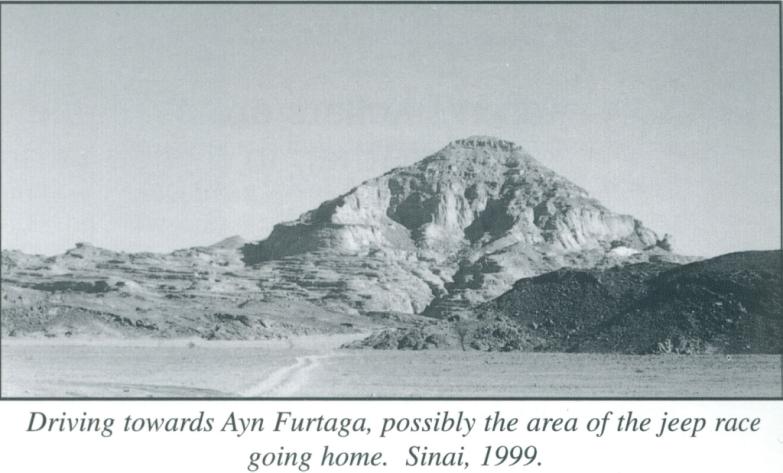 Slowly a broad gravel plain opened before us where speed could increase
and the yellow
jeep pulls up beside our jeep and the two young drivers eye each other,
and of all the incredible,
unbelievable things I could never imagine in my lifetime, a jeep race in
the middle of the gorges of Sinai
commenced! We were flying at who knows what speed across a gravel plain
between crystal granite
mountains. Had we hit anything at all we would have flipped over some way
and been thrown or crushed
or God only knows what.....but on we sped, me holding on for dear life,
thinking that in all likelihood this
is the end of my life!
Slowly a broad gravel plain opened before us where speed could increase
and the yellow
jeep pulls up beside our jeep and the two young drivers eye each other,
and of all the incredible,
unbelievable things I could never imagine in my lifetime, a jeep race in
the middle of the gorges of Sinai
commenced! We were flying at who knows what speed across a gravel plain
between crystal granite
mountains. Had we hit anything at all we would have flipped over some way
and been thrown or crushed
or God only knows what.....but on we sped, me holding on for dear life,
thinking that in all likelihood this
is the end of my life! Finally the ground became too rough to continue at full bore but our jeep had clearly won. The yellow jeep then faded from sight, in shame, obviously, choosing a different route through the remaining miles to the black top highway. However, as the two jeeps were racing along at life threatening speed, in addition to sheer terror, my mind filled with the recollection of the wonderful horse race from Carl Raswan's Drinkers of the Wind. I was reliving it.....the jeeps as the two horses, Raswan's stallion, Ghazal, and "the poor little blue-gray mare" of the old Ruala Bedouin. All these years the story had been dormant in my memory; Raswan is a great storyteller, whatever he may have lacked as an historian or ethnographer.....a story he could tell and as the jeeps raced along, the raggedy little mare reran her wild race.....she was there, I could feel her, hear her ancient rider hollering gleeful derision in the vastness. Raswan begins the story by describing the desert, the moment....a cloudless blue sky, a touch of approaching winter in the air, yet he is feeling sad and a bit apprehensive as his party leaves Damascus for the "unknown". His travelling companions are his friend, Marzuki, and elderly Ruala Bedouin, three men and three women, "small figures, weatherworn and almost in rags, riding fine-boned camels. One blue-gray mare was led by her halter rope." Raswan muses on the fact that travelling with Ruala Bedouin he was among the "outcasts of society", men who raided other tribes for horses and camels. He reflects on the fact that the Bedouin are going home to their desert, while he is full of apprehension, yet, upon hearing the desert lark's song, he suddenly feels free and urges his stallion into a gallop to join the camel riders. As he approaches the camel riders, he notes that as she moves along behind the swaying camels, "the poor little blue-gray mare" hardly lifts her legs. "Like pendulum rods they moved along without wasting any knee-action". As Raswan closes on the camel riders, one of the old Bedouin jumps onto the back of his "raggedy old horse", and gathering the rope in his hands, challenges Ghazal to a race. As we went off, I wondered how the man could trust himself to this skeleton. But from the very moment that he landed on her back, she became transformed, taking on a gallantry all her own. She looked amazingly racy and noble as she gathered herself with rider upon her witheThis should not be. Ghazal was now in better shape than he had been in Egypt. I leaned forward, laid my hand upon his mane, and cried, "Ghazali!" This should not be. Ghazal was now in better shape than he had been in Egypt. I leaned forward, laid my hand upon his mane, and cried, "Ghazali!" He answered with a loud neigh. He knew I wanted him to be serious. His hoofs drummed faster and faster over the hard gravel soil. Small stones peppered him as we came up to the gray mare. Side by side we raced with the yelling old man. The mare snorted, and laid back her ears. Her rider slid like a monkey back and forth, never touching the mare with his hands, though sometimes his naked feet knocked against her ribs. Ghazal's hoofs beat in the same wild rhythm as the mare's, but he could not overtake her, no matter how hard he tried. For ten minutes or more there was no gain, then slowly the mare drew away, with her old rider shouting and laughing at us. The Rueyli and his blue-gray mare had won the race. (Carl Raswan, Drinkers of the Wind, 1942, Creative Age Press, pp. 126-127) When the old Bedouin rides over to Raswan, whose horse is totally winded, the little mare "gave not a sound. Only her thin nostrils dilated, and she trembled slightly." And, her owner says to Raswan, "She blows like a feather over the ground", adding contemptuously, that a stallion will never outrun a war mare. And, I am convinced, that anywhere two men come together, on or in anything that moves, four legs or four wheels, they will have a race! Unbelievable, had I not actually lived through it, in memory and in the flesh. 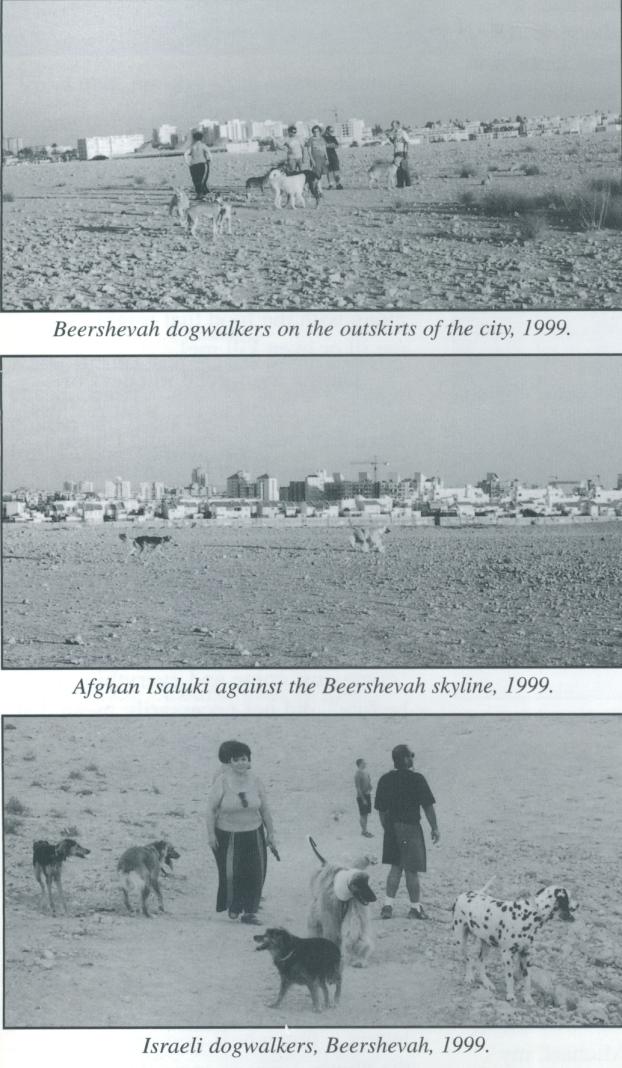
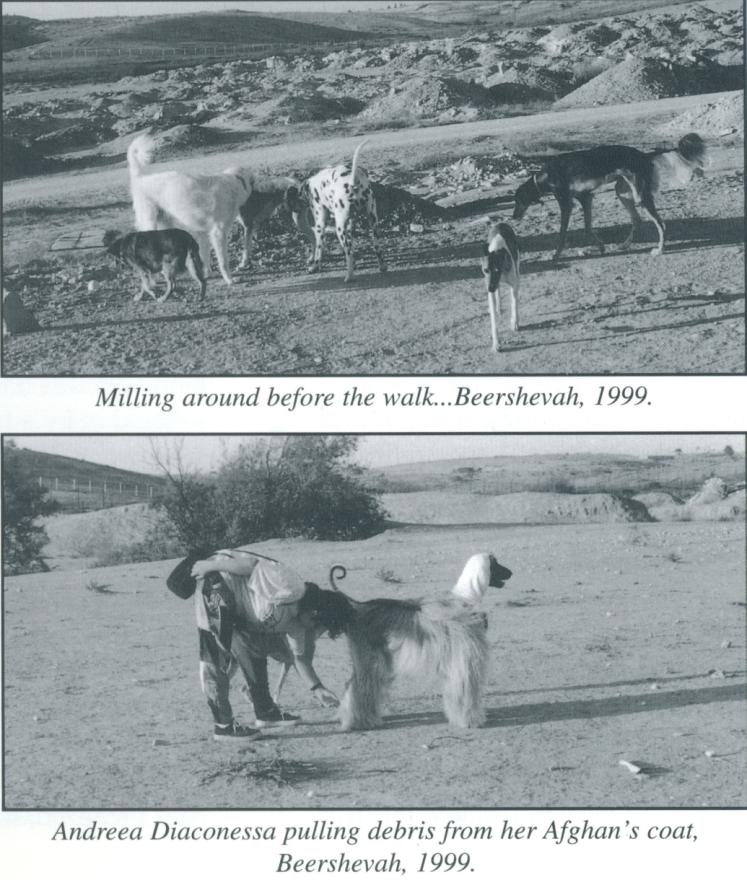 After taking leave from Dr. Bailey's friends in Nuweba, I experienced
another hair-raising ride back
to Beershevah, where he had an important noon meeting at Ben Gurion
University of the Negev. Egypt was
much easier to leave than to enter, despite the same routine with numerous
forms and fees. And though Dr.
Bailey was in a great hurry, he nevertheless stopped and gave individual
Bedouin or entire families rides
from point to point along the route. Once we got into the city of
Beershevah, there was bumper to bumper
traffic.....from the sublime of Sinai to Israeli gridlock! My Sinai
adventure formally ended at the
University with an indebted good bye to Clinton Bailey.
After taking leave from Dr. Bailey's friends in Nuweba, I experienced
another hair-raising ride back
to Beershevah, where he had an important noon meeting at Ben Gurion
University of the Negev. Egypt was
much easier to leave than to enter, despite the same routine with numerous
forms and fees. And though Dr.
Bailey was in a great hurry, he nevertheless stopped and gave individual
Bedouin or entire families rides
from point to point along the route. Once we got into the city of
Beershevah, there was bumper to bumper
traffic.....from the sublime of Sinai to Israeli gridlock! My Sinai
adventure formally ended at the
University with an indebted good bye to Clinton Bailey. Phase two of my journey began with a seamless transition into the "care" of Andreea Diaconeasa, who met me at the Aranne Central Library. I visited the library for an hour or so, looking at slides and photos from two archive collections which are part of the Tuviyahu Archives of the Negev. The Archive Librarian, Yehoshua Bar-On, kindly arranged a room for me at the Beershevah youth hostel, and Andreea dropped me off for a shower and a nap. She commented that I appeared near collapse. She was right. We agreed that at six she would return and my first Israeli dog encounter would occur....we would meet some of the Beershevah dog lovers who regularly get together just before sunset to walk their dogs on the outskirts of the city. I slept like a stone. At six o'clock Andreea arrived, bringing me some delicious potato borekas which I devoured, and off we went with her three whippets and afghan, towards the outskirts of town. As we pulled into the area there were already several cars, people, and dogs standing around, people talking...dogs, milling around, checking which "buddies" had arrived. The terrain was very rough but all the dogs, a small group of crossbred pets, one totally deaf and several very old, several purebreds, and one Saluki, navigated with abandon. I found it remarkable that the whippets held up running over the rocky ground at such speed, but Andreea said they had no injuries. We walked down through a wadi then climbed to a ridge with a deep gully between the two banks. The distance from the wadi where the cars were parked to the highway in the distance, at the end of the gully, was about half a mile or so. At the bottom of the gully and along both sides, intermittently, was scrub vegetation which, I was told, occasionally hid a hare or fox, to the delight and excitement of all walkers. A military base with chain link and double razor wire topped the bank opposite where we were walking. The occasional hare or fox, once flushed from cover, would run down the gully, up the opposite bank, and straight under the fence, but, as everywhere hounds chase quarry, the chase is always a thrill, in the moment as well as in the retelling of it. And the hounds never forget where quarry was flushed, so they ran from bush to bush, in hopes of rediscovering the source of excitement. Since the banks of the gully were fairly steep, this was excellent exercise for the dogs that did the searching, mostly the Saluki, Afghan, and whippets. Clearly, optimism is a universal sighthound characteristic. 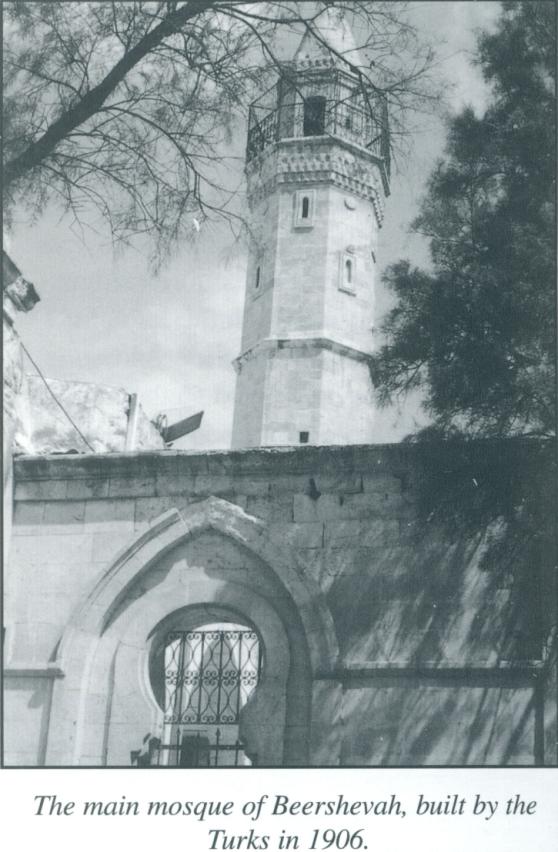 As the sun dropped we headed back towards the cars. In the gulch before the plateau area where the cars were parked, Bedouin had arrived with a large herd of fat- tailed sheep, several cows, a camel, several donkeys, dogs, and people. The Bedouin dogs barked at us as we approached and the Marana bitch and the Afghan male ran towards the Bedouin dogs, which were fairly large. The Israelis all called their dogs and the Bedouin dogs backed towards their flocks. Only the Afghan rushed forward and body slammed one of the Bedouin dogs, but then returned to Andreea, snood and leg wraps still neatly in place. Well exercised, dogs and owners got into their cars and we parted, making plans to search for Salukis in one of the Bedouin towns near Beershevah next week. Ruthie thought we could find Salukis if we drove around with her bitch in the car and said we were looking for a suitable mate. I thought that sounded like a good idea but we did not have to try it, in the end, because I made numerous contacts before returning to Beershevah. We were all to discover that the Negev region is full of Saluqis....Saluqis everywhere, once you know who to contact. Andreea dropped me off at the hostel and I finally unwound enough to fall asleep. I slept well but awoke early. I lay in bed wondering what microbes I might be incubating from Sinai, got up, took a sulfa pill, then fell back into bed, drained. Did I have hepatitis? Malaria? I fell back asleep, waking at eight, dressing, and going down for a delicious breakfast in the dining room. I sat with several guests and told them all that Sinai is a must, the trip of a lifetime, and I gave them our jeep driver's name and phone number. Though I don't actually know if he speaks English, he certainly knows Sinai.....so, they could just work through the communication problems! 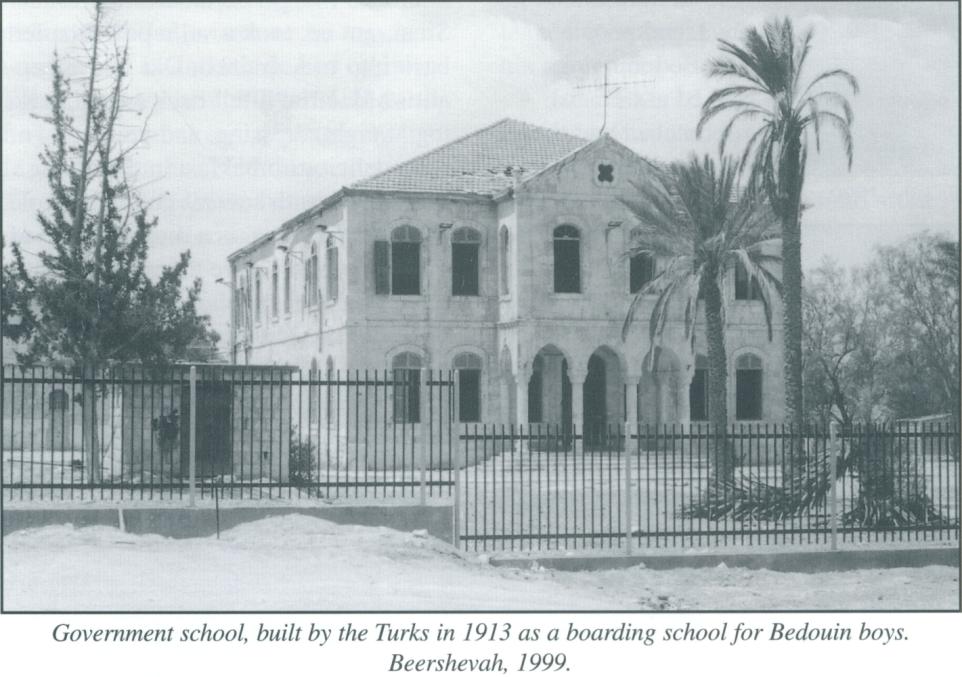 Before leaving Beershevah, Andreea wanted to show me the old city, so, we
made a walking tour for a few hours.
Before leaving Beershevah, Andreea wanted to show me the old city, so, we
made a walking tour for a few hours. The Turks governed the region for hundreds of years and there were many old Turkish buildings; most were gutted and deteriorating, but still interesting as architecture. There was a mosque, crumbling and defaced, which reminded me of the destruction and defacement I had seen in 1968, within the walls of the Old City of Jerusalem, of every building and symbol of Jewish life that had been present. Arabs had destroyed all Jewish symbols, including the Mount of Olives cemetery; the Jews of Beershevah obviously felt that they could destroy Arab symbols. It was hard to look at.....hard to reflect on. It makes peace appear so impossible. We continued to the central square which was closed to vehicle traffic and because it was Friday, it was full of vendors' booths, arts and crafts, even a Bolivian Indian trio playing guitar and flute music for passer-by donations, which came generously. After an enjoyable several hours it was time to take the bus to Jerusalem so that I would be sure to arrive before the Sabbath began, my niece and her family being observant Jews. Though I hadn't made a long bus journey in more years than I can remember, this trip from Beershevah to Jerusalem was only the first of several that I would be making. I eventually traveled from one end of Israel to the other, from one Saluqi region to another, by bus. Israeli buses run frequently, are clean and not expensive, and on Sundays, the first day of the workweek, carry most of the new recruits for the Israeli defense forces. However, I was the only gray haired grandmother lugging a suitcase full of Saluqi photos on the Israeli buses. That I did notice. This first trip was uneventful and I began to feel a sense of familiarity with the changing vegetation and topography as we made our way from the Negev desert region of rolling hills, the color of summer, toasted honey, towards the granite gray and conifer forest green around Jerusalem. Arriving at my niece's apartment, everything was as it had been when I left, with the exception of the new baby....she was home, so Shabbat was ushered in by a family of six, and Auntie Gail. When dinner was served, I found myself ravenously hungry! I had been so worried I'd "catch something" during the first week of my trip, I had barely eaten in Sinai. This delicious Shabbat dinner was eaten with abandon. After dinner, Michael, my nephew-in-law, commented that a trip like mine helps people appreciate "the simple things in life" like safe food. And I realized, maybe for the first time, what a feat of technology "safe food and water" actually are. I had never considered all that goes into the growing, shipping, preparing, and storing of food so that I could eat and not worry about what I might be ingesting along with the food that might make me ill or even kill me! During the forced idleness of Shabbat, I began to feel a bit restless, since time was passing and I hadn't actually seen but a few shadows of Saluqis. As soon as Shabbat ended, I started calling the various contacts I had in the northern region of Israel. Several were not available, and I began to worry that people who had been polite and welcoming on the phone, "come, just come and everything will be fine", did not necessarily mean that they, personally, would be making everything fine. Wishful thinking and optimism get lots of travelers onto planes, I'm sure. I was certainly one such traveler. My problem now was getting to Haifa, because Igal Sella, the man who sent me Dar and Div Tarabin, which were descended directly from Salim Ibn Jahzi's Ruah Tarabin, was waiting for me. After so many years of letters, a few words now and again on the phone, I was to meet this man who, along with the Ibn Jahzi family, I felt so indebted to. |